Psychiatrists and Sociologists who are experts in this field, broadly agree on a general principle which is that a terrorist group that systematically utilizes violence to reach its goals will also be utilizing some specific aspects of cult modus operandi according to contemporary definitions of cults [1]
What this means is that an organized entity which, for any stated reason, attempts to physically eliminate its opponents (as opposed to engaging with them in any other way) will be assumed to be employing mind control techniques (often referred to in common parlance as "brainwashing") in order to attract, recruit and maintain its recruits and to exert power over every aspect of their lives. Again, many scientists of human and social studies who have extensively studied this phenomenon agree that any cult, because of its unique characteristics, is potentially capable of using violence and physically eliminating not only its own members but also its opponents if it deems this necessary. Any cult will, in theory at least, believe this to be an absolute right.
Examination of a documented example in this regard is used here to open up this issue. In the following we first describe three interlocking circles of the structure and operations inside one clearly defined terrorist cult:
In the First Circle there stand the people who are trained to carry out terrorist activities and to ultimately destroy their own lives and those of the others. These individuals are proud of their terrorist acts and consider this, within the framework of their ideological system, to be the highest pinnacle of purity and sacrifice. This ‘ideological’ framework is significant because of course the direct perpetrators of terrorist acts are themselves the prime victims of terrorism but unfortunately are quite unaware of this bitter fact. It is due to this framework that the fact that some suicide bombers do not inflict casualties as a result of their own deaths does not stop others from following them.
In the Second Circle there stand the people who play the role of intermediates between the leader of the organization and those who are tasked to act in the actual scene. It is these individuals who put into practice a specific process of psychological manipulation or mind control which will prepare the people in the first circle to carry out terrorist operations. These individuals are so thoroughly dissolved in the system of the organization that they are capable of sincerely and uncritically imposing these mind control techniques on others.
In the Third Circle there stand the leaders of the cult who have developed a mask to portray freedom and humanity to the members of their cult and beyond this to the outside world where their purported advocacy of democracy and human rights is designed to distance them from the actual victims of terror on both sides. Cults are not what they show. Cult leaders are expert at covering their actual nature and easily show a different face from their actual one to those who do not know them.
Now we describe a documented example using the framework of those connected circles which comprise the structure of a terrorist cult. The case study has been chosen from the Mojahedin-é Khalq Organization (MKO). This organization according to current sociological definition is a destructive cult. [2]
First Circle
Around March 2001, three individuals named Garshasb Soleymanian, Mas’ud Bakhshi and Amir Gudarzi, who had been trained militarily and ideologically in the MKO camps in Iraq under the hegemony of Saddam Hussein, were sent to a city inside Iran to perform a terrorist act. They were eventually killed in a street clash with law enforcement officers. The news relating to this clash along with their biographies was published in Mojahed, a Persian language newspaper, the main publicity organ of the MKO at that time. From the text and tone of their letters to their commanders and their wills, we can derive the kind of preparation that all three underwent for the mission and identify the specific psychological manipulation which takes place under the heading ‘Internal Ideological Revolution’. The mind-set of all three is that they are acting as saviours by conquering the city and freeing the people. They apparently believe that all these people are waiting for the arrival of their commanders after they have cleared the way for them. Such evidence of psychological manipulation, which often also includes forms of coercion, which is imposed on the operational individuals in the ‘first circle’ can be found in most cults. It is this which guarantees the operation being performed whatever the price might be and that the next individuals with the same mental mechanism get ready to finish the unfinished task of their previous colleagues. In this regard, the cult attaches specific, value laden attributes to their operatives which are highly significant: “the proud hero of the scene of commitment and bearing responsibility, the courageous Mojahed-é Khalq commander, with the will like steel, the heroic Mojahed, the young blood of the sun . . .” (The sun is often used in the MKO as an analogy for cult leader, Maryam Rajavi)
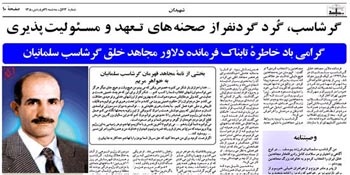
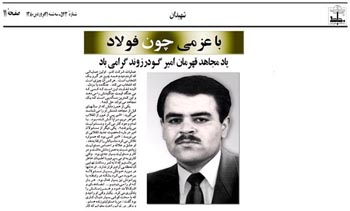
(Memorize the three photos of the three persons above)
Garshasb Soleymanian writes in his letter to "Sister Maryam" (Maryam Rajavi) that: "I thank God thousands of times particularly when I see that I would have not reached the values of your revolution (the MKO’s Internal Ideological Revolution [3]) elsewhere. If you had time, please pray for me that I be able to fulfil the commitments of being your soldier with my maximum assault against the enemy". The lexicon of cult indoctrination embodied in this letter clearly demonstrates the cultic relationship of the devotee to the leader.
Second Circle
We mentioned that the people who commit acts of terror are the prime victims of their own actions, but at the same time are proud of killing and maiming and they are convinced that their action is holy and divine. This mind-set is strikingly at variance with that of ordinary, un-indoctrinated people in every society who would not be proud of launching mortal shells on a city. Quite to the contrary, when hearing of such acts of terror people become fearful and disappointed. So, how is it possible that some can shed the blood of others and be proud of their deeds?
The person standing in the second circle is instrumental in converting normal people into killers. How do they think and what techniques do they use?
Ms Sediqé Hoseyni, currently First Secretary of the MKO in Iraq and in the Ashraf Camp, met up with the team identified as First Circle members above just before they embarked on their terrorist mission. In the meeting she conveyed to them the message of their Spiritual Leader, Maryam Rajavi, in order to boost their morale. This was the farewell meeting between the followers and the messenger of the guru in order to prevent the individual having any doubts about what he is about to do. He must prove with his operation that he has reached a high level of obedience to Maryam Rajavi. At the same time, as the go-between, Sediqé Hoseyni sincerely believes in what her recruits are about to do.
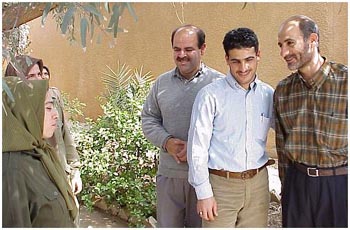
(Sediqé Hoseyni in her last visit with the operational team)
Third Circle
Now we move to the top of the pyramid of the cult in order to examine the practical mechanism of cults and to better understand their true content. The recruits into a cult are indoctrinated into worshiping the cult leader – in this case the Spiritual Leader, Maryam Rajavi. All members of the MKO are equal in only one aspect and that is their adoration of the leader and this is their only right within the cult. Indeed, the value of an individual inside the cult is measured solely by the mental, emotional and moral proximity they have to the leader. (Interestingly, if the recruit did not want to stay or could not do so in the determined framework, the very same person would within a day become, in the language of the cult, a traitor, defector and mercenary of the enemy.)
Ms Sediqé Hoseyni has proved the extent of her ideological faith in the spiritual leader by successfully passing all the phases of the Internal Ideological Revolution and being able to to indoctrinate others in it. In this respect she has passed all the stages of submitting to the demands of the cult leader. It is for this very reason she has now been chosen and introduced as the First Secretary of the MKO.
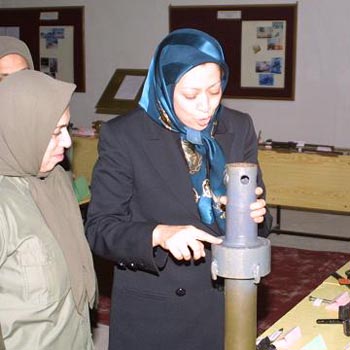
(Maryam Rajavi and Sediqé Hoseyni in a military workshop in the NLA in Iraq)
Allocation of rank or position in a cult is not done according to the capabilities, abilities, or personal talent of the individual. The main factor is the extent of dependence on and submission to the cult’s leader. For the individual member, this is a difficult matter to prove. Other members of the cult must be able to testify that that particular person has dissolved into the system and denied their own identity and has replaced it with the identity of the leader. They must have become a ‘transparent’ person and most important of all must be judged to have reached the fullest understanding of the absolute spiritual leadership. In the MKO, one of the ways to prove that is the success of the teams trained by the person and how effectively they have learned to either kill or get killed.
Remember that the leaders of the cult adopt a peaceful appearance and present democratic and liberating slogans. However, a cult exists in direct conflict with the outside world (‘us’ and ‘them’) and through a process of psychological manipulation or mind control can convert even the most honest peaceable of persons into terrorists and murderers to defend itself as an entity.
Mr Ali Moradi a former member of the MKO cult returned home to his family after the fall of Saddam Hussein’s dictatorial regime. He writes about Sediqé Hoseyni as follows:
"She gradually rose in the ranks of the MKO. After a while, Sedeqé became the deputy commander of Axis 3 of the National Liberation Army (NLA) [the Mojahedin’s military wing]. She was then moved to Centre 11. After a while some young people who had recently been deceived into the organisation moved to her part and underwent the brainwashing processes. After a year at Centre 11, Sediqé became the deputy and then the commander of Centre 17. This was about the same time that an agreement was reached with the former Iraqi dictator Saddam Hussein to send teams inside Iran to undertake sabotage activities. Then Sediqé moved to the city of Kut in Iraq as the Chief of Staff of Centre 5. She was chosen to guide and control the teams who were nominees to be sent to Iran since she was very stubborn and inflexible. The Mehran, Shalehabad, and Dehloran regions were the areas that her teams were to perform their operations. In this base she managed to brainwash many teams with the aid of some well known MKO torturers and interrogators such as Assadollah Mosanna, Naqi Arvani, Mohammad Reza Mohaddes, and Kamal Niknami and to prepare a few terrorist teams. These teams were first settled in separate compartments and were shown made-up films and were given special training and education in order to be able to kill without mercy inside Iran. One of masterworks of Sedeqé was to convince the team members to use cyanide pills if they are about to face any danger.
In this period the team of Abdolkarim Mahmudi and his companion and the team of Gashtasb and Mas’ud Bakhshi and their companion and some other teams were sent to perform terrorist operations which resulted to their deaths. Also the clashes in the region of Chilat which resulted to the death of Allahmorad Chaghaleh and Shahram Juyandeh and their companion were the works of Sediqé Hoseyni. There were several teams which were trained and sent to Iran under the command of Sediqé of whom there is no trace of their destiny whatsoever. In this period Sediqé, played a decisive and active role in training and sending terrorist teams to Iran and she was totally obedient to the desires of Rajavi the leader of the MKO. She always used to say that a successful commander is the one who would not care about the lives and safety of his/her recruits since this sort of consideration would create an obstacle to complete missions. Therefore since her way of accomplishing tasks was quite desirable to Massoud and Maryam Rajavi, she was appointed to become the Commander in Chief of the Fourth Army of the NLA. In the army she showed her total compliance until was appointed to be the deputy of Mozhgan Parsayi [at that time First Secretary of the MKO].
But another era of Sediqé’s struggle which appears to be the main factor for her ascending was her suppressive role in the process of family visits to Camp Ashraf after the fall of Saddam Hussein in 2003. She introduced a new thesis and gave the formulae: Family = nest of corruption and Family = anti struggle, which she wrote on the board. She held several sessions before any meeting with the family to indoctrinate the members who were about to face their relatives with these formulae. She used to say that we must be firm against the nest of corruption and anti struggle and against our family and oppose them. Therefore before any meeting she used to hold compulsory sessions for those who were about to meet their families and Sediqé used to brief them that the families have come on a campaign and therefore we must either fight them back when we meet them or do not go to the meeting at all. People were instructed not to receive photographs, not to embrace or kiss each other, not to cry, not to show emotions, and not to divert the political discussions to emotional ones. She used to instruct people so as to finally leave them with a cold and impassive attitude. She wanted them to prove to their families that they are the children of Massoud and Maryam. Anyone that Sediqé suspected to be anxious to visit their family was prevented by using different excuses from meeting with the family.
This reference to the words of Mr Moradi is not to deal with the personal character of Ms Sediqé Hoseyni since we must believe that she is herself a victim of the cult before anything else, and she has been a victim of mind control in the system of the cult in such way that she is capable of brainwashing others with absolute sincerity. Certainly any member in her position would have acted in the same manner. The aim of this article is to expose a connection between the two phenomena of terrorism and cult by analysing the two inseparable principles of ‘armed operation’ and ‘current operation’ which operate in the MKO. The term armed operation refers to the principle of using violence to achieve the aims of the cult. The term current operation refers to the necessity for all members at all levels to undertake ongoing psychological manipulation through ritual daily confession and repentance sessions.
In the above example of one specific terrorist organisation, the connection between its internal cult relationships (mind control – or psychological manipulation and the total submission to the cult leader) and its external relationships (committing acts of violence against its own members and the outside world) are clear. With even a general understanding of the nature of cults, Ali Moradi’s description above of the behaviour of the MKO’s current First Secretary Sediqé Hoseyni can leave no doubt that the MKO is a cult. Beyond this, his testimony exposes the underlying connection between cult methodology and terrorism in an organisation having the three above mentioned interconnected circles.
According to the teachings of the MKO cult, the recruits of the organisation must be devoid of any emotional feelings toward their beloved ones and their families. They must stop their contacts with them in order to become good tools to carry out terrorist acts. Again according to the teachings of the cult, the recruits must mentally reach a point at which they truly believe that they are absolutely nothing and they are of no value whatsoever and their lives are only to be sacrificed for their leader in a terrorist operation. Those who have submitted totally and can pass this value to others and turn them into robots who can perform the terrorist operations better, will rise higher in the system of the cult. These known methods and techniques are not used solely by the MKO. Nearly all terrorist organisations and even mafia type gangs utilize these psychological techniques, otherwise they would not be able to persuade their members logically and with open discussion to endanger other people’s lives as well as their own and ask them to carry out blind armed operations and blow up a hand grenade in their own belly or to take cyanide pills.
The role played by Sediqé Hoseyni in the family relations of cult members as described in the testimony of the member returned from Iraq is a common characteristic of all cults. Basically, one of the most underscored points of differentiation between cults and lawful organisations is their viewpoint on the family and family values. All established religions and popular parties and groups would look at the family as a valuable establishment which must be at least respected if not encouraged. On the contrary, cults, in any form that they might take, ultimately consider family relations and its values as their enemy. Cults only tolerate family connections in two ways. One is to recruit potential members and the other is to gain money from them. Accepting family values and terrorism do not match together. An individual who is tasked to take the lives of other people must initially suppress their own civilizing and humane behaviours. An individual indoctrinated by a cult into evacuating themselves of any feelings would not have any qualms about planting bombs in public places and taking the lives of innocent people.
The direct relationship between a terrorist act and the cultic relationship is the basis for this article and it is hoped this example will provide a starting point for further investigation into this link.
Notes:
[1] There are several generally accepted definitions of what differentiates a cult from other similar entities.
The late Margaret Singer, clinical psychologist and once Professor of Psychology at the University of California, Berkeley was the preeminent cult expert of the 20th Century. She counseled and/or interviewed thousands of people affected by controversial groups often called cults. Dr. Singer offered meaningful definitions of unsafe groups or cults in her book Cults in our Midst.
According to Dr. Margaret Singer, unsafe groups or cults can generally be defined by three factors:
1. The origin of the group and role of the leader.
2. The power structure, or relationship between the leader[s] and the followers.
3. The use of a coordinated program of persuasion, which is called thought reform [or more commonly, ‘brainwashing’].
A more specific definition can be taken from the Cult Information Centre:
Every cult can be defined as a group having all of the following five characteristics:
1. It uses psychological coercion to recruit, indoctrinate and retain its members;
2. It forms an elitist totalitarian society;
3. Its founder leader is self-appointed, dogmatic, messianic, not accountable and has charisma;
4. It believes ‘the end justifies the means’ in order to solicit funds and recruit people;
5. Its wealth does not benefit its members or society. [2] The term destructive cult refers to a cult which poses a danger to its own members and/or the outside world.
HOW TO DETERMINE IF A GROUP IS A DESTRUCTIVE CULT
Q) Anybody can unfairly attack a group they disagree with by calling it a cult or saying they are using coercive mind control. How does FACTNet prevent this type of problem and determine fairly whether or not a group is a cult?
A) FACTNet uses specific criteria to determine if a mind control system has been used, and does not suggest organizations are destructive or dangerous cults without careful research and determination that the evidence fits definite criteria. These criteria are threefold.
The first set of criteria comes from the groups’ use of a specific set of mind control tactics. Please see "A technical overview of mind control tactics" at http://www.factnet.org/rancho1.htm for details or see http://www.factnet.org/coercivemindcontrol.html for a shorter version. These two documents are derived from the work of Dr. Margaret Singer former professor emeritus at the University of California at Berkeley, the acknowledged leading authority in the world on mind control and cults.
The second set of criteria has to do with defining other common elements of mind control systems, as defined by Robert Jay Lifton’s eight point model of thought reform. Please see "Robert Jay Lifton’s Eight Point Model of Thought Reform" also at http://www.factnet.org/rancho1.htm. If most points in this model are being used in a cultic organization, it is most likely a dangerous and destructive cult.
The third set of criteria have to do with defining common elements of destructive and dangerous cults. The following section will help clarify what some of those specific elements and criteria are.
Common Properties of Potentially Destructive and Dangerous Cults
The cult is authoritarian in its power structure. The leader is regarded as the supreme authority. He or she may delegate certain power to a few subordinates for the purpose of seeing that members adhere to the leader’s wishes and roles. There is no appeal outside of his or her system to greater systems of justice. For example, if a school teacher feels unjustly treated by a principal, appeals can be made. In a cult, the leader claims to have the only and final ruling on all matters.
The cult’s leaders tend to be charismatic, determined, and domineering. They persuade followers to drop their families, jobs, careers, and friends to follow them. They (not the individual) then take over control of their followers’ possessions, money, lives.
The cult’s leaders are self-appointed, messianic persons who claim to have a special mission in life. For example, the flying saucer cult leaders claim that people from outer space have commissioned them to lead people to special places to await a space ship.
The cult’s leaders center the veneration of members upon themselves. Priests, rabbis, ministers, democratic leaders, and leaders of genuinely altruistic movements keep the veneration of adherents focused on God, abstract principles, and group purposes. Cult leaders, in contrast, keep the focus of love, devotion, and allegiance on themselves.
The cult tends to be totalitarian in its control of the behavior of its members. Cults are likely to dictate in great detail what members wear, eat, when and where they work, sleep, and bathe-as well as what to believe, think, and say.
The cult tends to have a double set of ethics. Members are urged to be open and honest within the group, and confess all to the leaders. On the other hand, they are encouraged to deceive and manipulate outsiders or nonmembers. Established religions teach members to be honest and truthful to all, and to abide by one set of ethics.
The cult has basically only two purposes, recruiting new members and fund-raising. Established religions and altruistic movements may also recruit and raise funds. However, their sole purpose is not to grow larger; such groups have the goals to better the lives of their members and mankind in general. The cults may claim to make social contributions, but in actuality these remain mere claims, or gestures. Their focus is always dominated by recruiting new members and fund-raising.
The cult appears to be innovative and exclusive. The leader claims to be breaking with tradition, offering something novel, and instituting the only viable system for change that will solve life’s problems or the world’s ills. While claiming this, the cult then surreptitiously uses systems of psychological coercion on its members to inhibit their ability to examine the actual validity of the claims of the leader and the cult.
http://www.factnet.org/rancho5.htm
[3] Internal Ideological Revolution
Introduced at the time of the marriage of Massoud Rajavi with Maryam Azdonlou in February 1985. Rajavi declared himself the self-appointed ideological leader of the Mojahedin, or spiritual leader – a role taken over in public by his wife Maryam Rajavi since his disappearance after the fall of Saddam Hussein in 2003.
Along with this role he introduced ‘phases’ of the Internal Ideological Revolution which would in his terms lead the members to a full understanding of his ideological beliefs. The phases included daily reporting of thoughts and feelings; forced marriage followed by forced divorces; separation of children from parents; confession of sins including erotic dreams and fantasies. The aim of these phases is to connect the member to the leader with nothing between them in an exclusive relationship of total submission to the leader’s will.
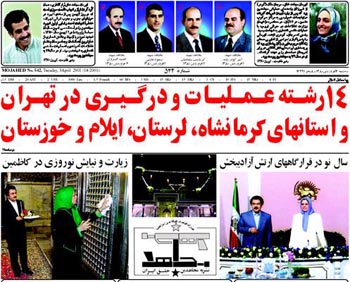
Iran interlink, February 2007
